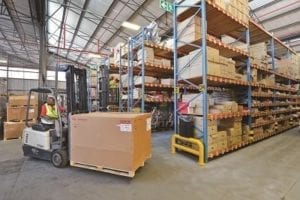Port warehouses have some unique requirements that inland warehouses do not, as Transport World Africa finds out.
Warehouses in and around ports often need appropriately surfaced, open yard areas to accommodate the handling of heavy containers. These warehouses frequently specialise in heavy lifts, project and abnormal cargo, meaning their architectural design and material handling equipment requirements differ from inland warehouses. Forklifts, front-end loaders, reach stackers and gantry cranes facilitate the handling of a variety of commodities at the ports. A port warehouse needs to consider the use of overhead gantry cranes to lift heavier items and/or containers and it is often necessary for an on-site rigger to be employed to oversee special lifting jobs. Due to the nature of the goods being imported and exported, fumigation, lashing and dunnaging services are often needed, while private rail sidings are used to assist in the movement of bulkier items. Software While warehouses at ports are different to those inland, they do share several similarities. The accurate tallying, receipting and dispatching of cargo, for instance, are typically managed by a high-tech scanning, weighing, and electronic warehouse management system (WMS). The chosen WMS software package helps with the management of inventory, storage locations and workforce, ensuring that customer orders are efficiently picked, packed, and shipped. A typical WMS manages every item in a warehouse, irrespective of type or location. It evaluates a warehouse’s physical dimensions, its storage locations and how it is packed by vendors, meaning it can orchestrate the flow of people, machines, and product. Automation Warehouse automation enhances warehouse efficiencies, reduces operating expenses and increases throughput and performance. Automation can yield better returns on investment and lowers the reliance on labour, which, in South Africa, can be expensive and is often interrupted by industrial action. Automation also lends companies a measure of prestige, streamlines their supply chains, and is an environmentally greener practice. There are varying levels of automation available and the choice to fully automate, partly automate or automate a particular task only, will depend largely on one’s individual requirements and budget. But while there are advantages to automation, there are also disadvantages. The most significant disadvantage is inflexibility, followed closely by the need for considerable capital outlay. South Africa is challenged by high unemployment levels, and job creation has to be considered before replacing human resources with costly robotics and conveyors that require maintenance and servicing by pricey experts. If something goes wrong, it’s likely that everything comes to a grinding halt until it’s fixed. Automation works best for companies that can project long-term stability and growth, and where labour costs, stock volume and stock movement are high. Most labour costs are spent on picking, so products that are uniformly packed and easily moved are the ones that benefit the most from automation. Products that differ in size and packaging are more suited to manual picking processes.Security
Theft, vandalism and damage to stored goods can be mitigated with a combination of round-the-clock CCTV video recording, high-tech access control systems and metal detectors. Smartly located fire sprinklers and smoke detectors, alarm systems at emergency exits, and burglar alarm systems are used to secure the premises. For the goods themselves, pallet wrapping and container liners secure and protect goods from damage during transit. Expanded metal ensures the safety of people and warehoused items inside the facilities. When compared with conventional fencing, expanded metal offers increased security, coupled with unimpaired visibility. It is particularly ideal for applications that include inventory-holding sections of manufacturing plants and warehouses. Safety Warehouse accidents and injuries are a global concern. But it’s possible for warehouses to reduce accidents and limit injuries by taking proper safety precautions. This means ensuring that staff and managers are continually trained in warehouse safety. Adherence to all relevant fire and safety codes, such as those stipulated in the Occupational Health and Safety Act, No 85 of 1993, need to be practiced religiously and not just be verbally agreed to. Many accidents can be avoided if staff are frequently trained on the subject of safety. This includes proper forklift operation and hazardous materials handling training. Warehouse staff should also know how to use fire extinguishers and know where they are located. Regular racking inspections will need to be carried out to check racking integrity and strength. Attention must be paid to the warehouse floor, which should be free of clutter, tidy, and smooth. Pallet stack heights must be limited and forklift/pedestrian separation barriers, cameras and light signalling systems should be introduced. The fitment of guard rails along vehicle paths, and around employee areas and machinery, is vital. In more sophisticated warehouses, vertical reciprocating conveyors are used as an alternative to forklifts in certain areas. Automated guidance vehicles, or AVGs, also work as suitable replacements for manually driven forklifts. Energy Environmentally friendly measures help save on energy requirements and lower a warehouse’s carbon footprint. Solar photovoltaic roof panels generate electricity while solar thermal panels heat water. Ground-source heat pumps heat and cool offices while rainwater collection systems are used to flush toilets. Improved lighting systems offer warehouses and clients that use them the potential for significant savings on electricity while transparent building materials are used in the development phase to increase the amount of natural light that enters the warehouse.







